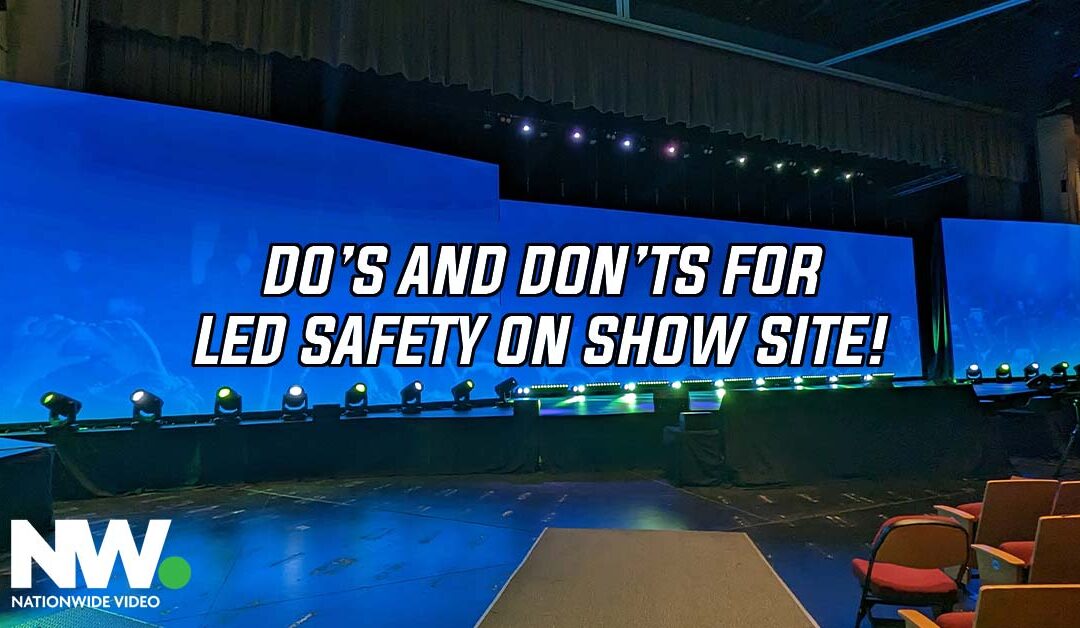LED walls have become a staple in modern events, providing great solutions for the live event industry. However, working with LED panels requires careful attention to safety to prevent accidents and damage to tiles. With help from Nationwide’s LED & Innovation Strategist, Brett Thierbach, we put together a list of the do’s and don’ts of LED safety on show sites, ensuring that your LED wall assembly is efficient, damage-free, and injury-free.
The Do’s:
- Clear the Work Area: Before starting the LED wall assembly, ensure that the work area is clear of all obstructions and potential trip hazards. Remove any cables or clutter from the vicinity to provide a safe working environment.
- Limit Unnecessary Personnel: Keep the build site free of personnel or gear not directly involved in the assembly process. Minimizing distractions will improve focus and reduce the chances of accidents.
- Organize the Tile Cases: Bring the tile cases as close to the build site as possible for easy access. Use the lid of another tile case as a work surface to hold all the cables neatly, avoiding tangling and confusion.
- Properly Handle Protective Foam Covers: When removing a tile from its case, be mindful to place the protective foam covers back into the empty slot. This step prepares the case for when it comes time to strike the wall.
- Mindful Tile Placement: If you need to set a tile down during assembly, always place it back into a clean case free of debris and cables. If you must set the tile down outside the case, choose a strong and level surface to avoid potential damage.
- Provide a Safe Platform: Ensure the assembler has a level and secure platform to work on. Avoid using the top rung of a ladder or leaning beyond the safe edge of a scissor lift, as it can lead to accidents.
- Check Levers and Gates: Before handing the assembler a tile, make sure all levers and gates are in the proper position. Retract edge guards to prevent damage to neighboring tiles’ diodes.
The Don’ts:
- Avoid Premature Tile Removal: Refrain from removing tiles from their cases or protective foam covers until you are ready to place them in the wall. This prevents accidental damage during handling.
- Single Tile Handover: Do not have multiple people trying to hand a tile to the assembler simultaneously. This can lead to confusion and mishandling of the tiles.
- Mindful Tile Placement: When inserting a tile into the wall, be cautious not to hit the already assembled tiles, as contact can damage the pixels. Let the magnets draw the tile into the correct position gradually.
- Tile management: When tiles are not in use, be sure to never stack LED on top of LED without protective foam. Additionally, be sure to lean tiles on their back as opposed to on the tile face to protect the tile surface.
- Avoid Rushing: Take your time during the assembly process. Although today’s LED tiles may assemble quickly, rushing increases the risk of mistakes and potential damage. Taking care during assembly will save time and effort in the long run. When striking, be sure to hold the tiles when releasing their clamps to avoid accidental drops.
- Cable Management: Don’t begin striking tiles before you’ve taken care of cables. Data and power cables can be a major liability when striking if left connected. Be sure to disconnect them so they don’t complicate the strike when it comes time to remove the tiles.
Working with LED walls on show sites requires strict adherence to safety guidelines. Following the do’s and don’ts listed above will help ensure a smooth and safe LED wall assembly process. By creating a well-organized work environment and focusing on careful handling, you can protect both the well-being of your team and the expensive equipment.
In the event that you have ended up with damaged tiles, Nationwide Video is here to help. With a team full of LED Repair Technicians, we can get your tiles up and running again in no time! https://nationwidevideo.com/led-tile-repair/
Photo courtesy of Live Event Solutions. To see more of their work, check out https://www.liveeventsolutions.net/

